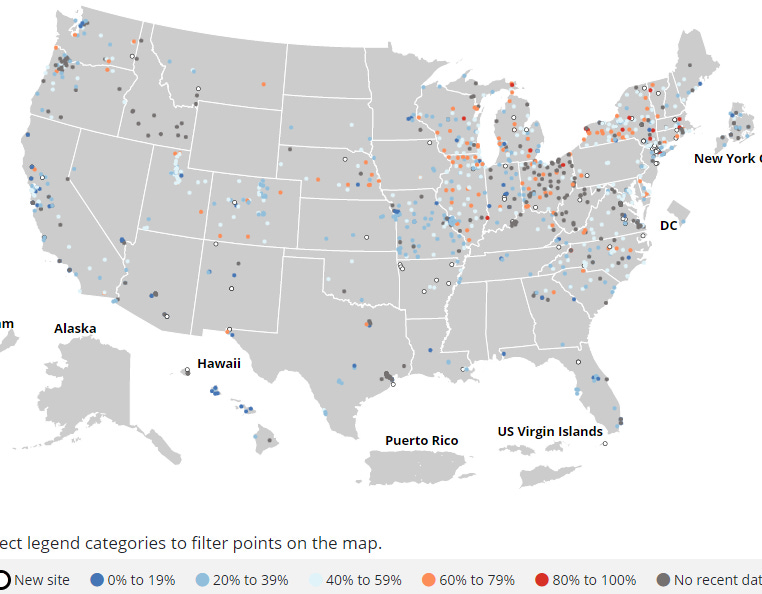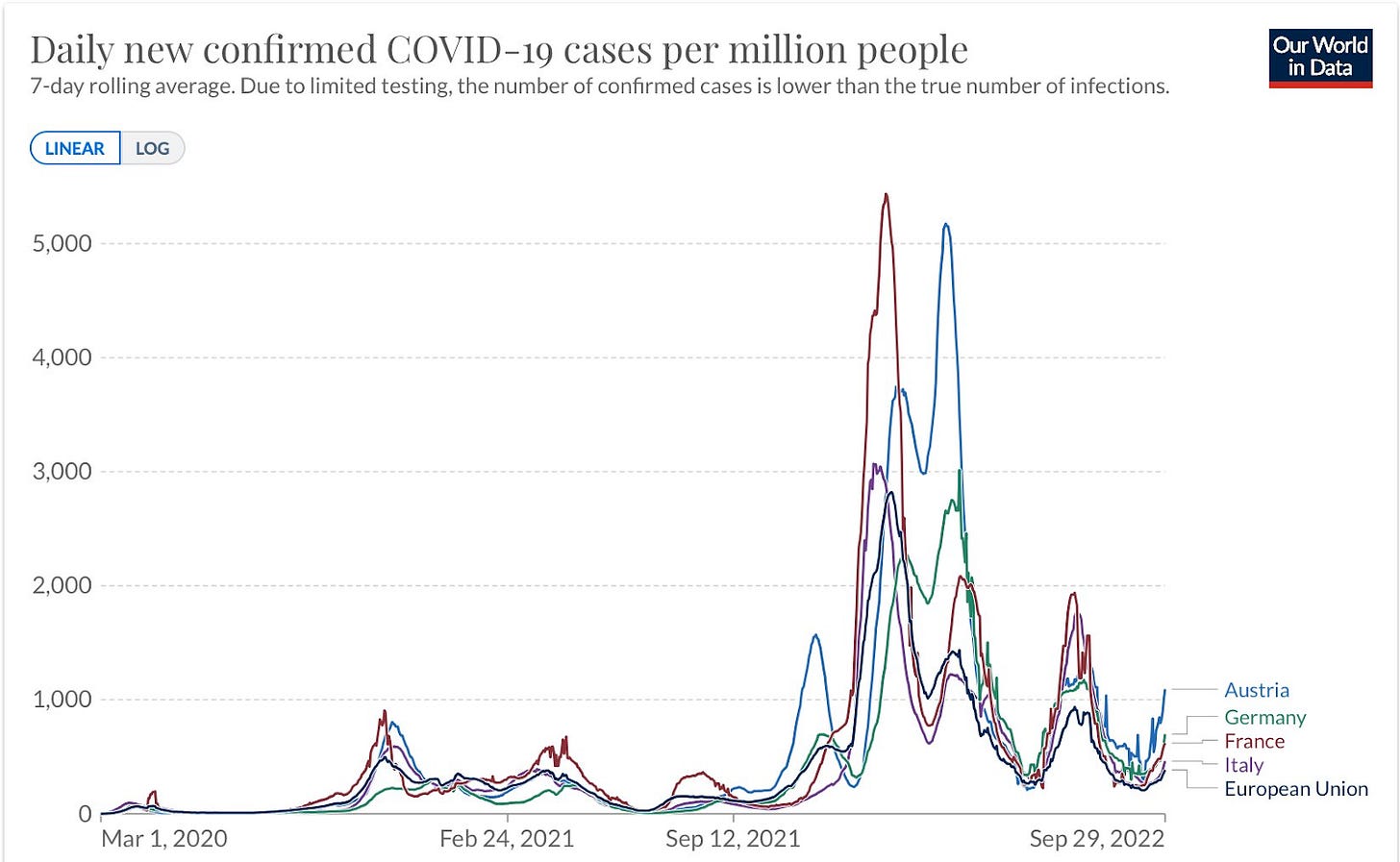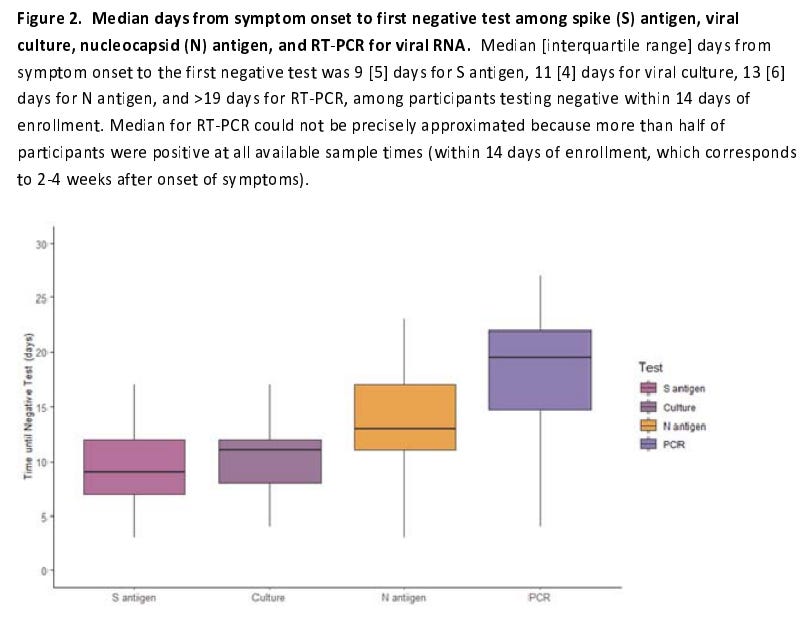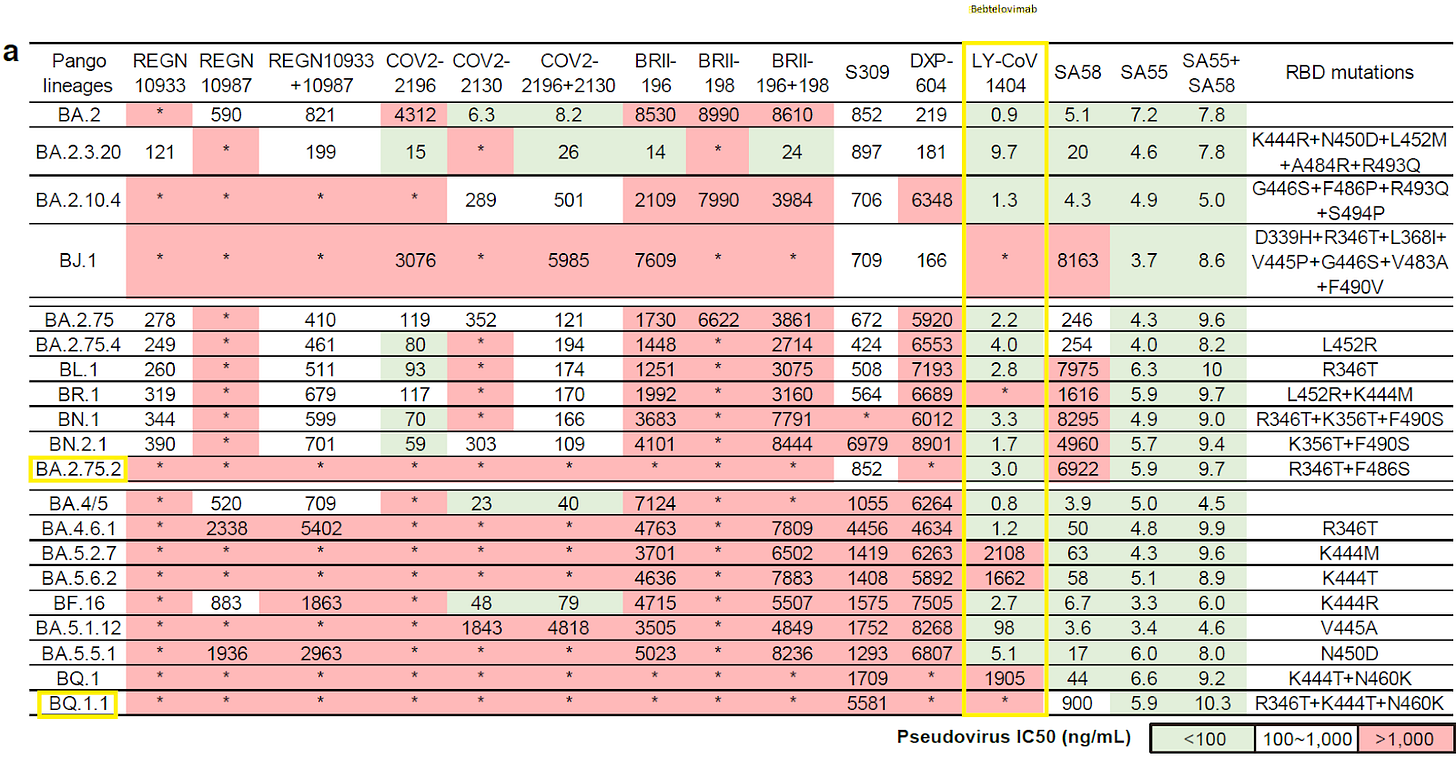Hi all,
This week, the CDC came out with a warning about an increase in acute respiratory illness in children and teens with rhinoviruses and enteroviruses, including Enterovirus D68. Enterovirus D68 (EV-D68) can cause severe respiratory disease and it can also cause a polio-like condition called Acute Flaccid Myelitis (AFM) in children and teens. Emergency departments and Pediatric ICUs are filling with sick kids in some places like Chicago, so it may not be a bad idea to take precautions.
Regarding COVID, numbers are going down in the US but are still significant at 48,000 new cases per day and 400 deaths per day. We are starting to see an uptick in wastewater virus levels in the northeast and new COVID waves are starting in Europe (Austria, Germany, France, and Italy). In addition, hospitalizations for COVID are increasing in Germany, France and the Netherlands. Science magazine reported on two new variants of interest, BA.2.75.2 (Chiron) and BQ.1.1 (Cerberus) that may have the potential to cause new waves. Many of the newer variants of interest like BA.2.75.2, BA.4.6, and BF.7 are resistant to Evusheld (Tixagevimab + Cilgavimab) which is the monoclonal antibody cocktail that is given to immunocompromised people for protection. All of the variants mentioned are still sensitive to the monoclonal antibody Bebtelovimab, with the exception of BQ.1.1 which is resistant to both Evusheld and Bebtelovimab. Raj Rajnarayanan is following different variants of interest and he specifically is following BQ.1.1 here.
In the US, BA.4.6 has risen about 1% per week for the last few weeks and is now at about 12.8% of cases. BF.7 increased from 1.4% last week to 3.4% of US cases this week, so we will have to keep an eye on it too.
The CDC put out a statement this week that they no longer recommend universal masking in hospitals and nursing homes. This is not wise for several reasons. People in nursing homes and those in hospitals are often the most vulnerable to COVID infections. If healthcare workers don't wear masks in the hospital, they risk getting COVID infections which could make them sick which would affect hospital staffing. In hospitals that still do require masks, some people who do not want to wear them may become belligerent causing safety concerns. Plus, during the fall and winter, people will stay indoors and will have an increased risk of getting a COVID infection, especially if they are not masked.
The new bivalent BA.5 boosters are out but we need better public health messaging to urge people to get them. Many of the new variants of interest are descendants of BA.4 and BA.5 and the new bivalent vaccine may protect better than previous vaccines. Previous boosters significantly decreased hospitalizations and deaths in prior waves. A new study shows that immunization with an antigenically distant spike (like BA.5) can overcome the antigenic imprinting of the primary vaccination series (original wild type virus) by inducing robust Germinal Center B cell response. The new boosters are important and are available for everyone over age 12 who has had their primary COVID vaccination series. You can find available bivalent COVID booster vaccines and flu shots at https://www.vaccines.gov/search/.
A new small study of 150 healthcare workers showed that testing plasma for a certain proteomic signature during a COVID infection can predict who will get Long COVID. Looking at these specific proteomic pathways, we may be able to get clues on what treatments could help prevent Long COVID. Also, patients with a higher risk for Long COVID could receive earlier testing or rehabilitation exercises to help treat symptoms before they happen. This study needs to be repeated in a larger population to confirm these important findings.
Have a good weekend,
Ruth Ann Crystal MD
Twitter: https://twitter.com/CatchTheBaby
9/28/22 CDC: Increase in Acute Respiratory Illnesses Among Children and Teens with Rhinoviruses and Enteroviruses, Including Enterovirus D68 https://buff.ly/3SE7wzn
Enterovirus D68 (EV-D68) caused biennial outbreaks of severe respiratory illness and acute flaccid myelitis (AFM) in the United States in 2014, 2016, and 2018.
The CDC reports a rise this summer in pediatric cases of three respiratory viruses: rhinovirus, enterovirus and the more severe enterovirus D68 (EV-D68).
If a child presents with AFM symptoms, check for EV-D68.
Rhinoviruses typically peak in spring and fall, while enterovirus is late summer and early fall.
Rhinovirus and all of the other viruses are making a comeback and filling the PICUs
—----------------------
COVID news:
https://charts.medriva.com/worldmonitor
World
United States
Iowa data is obviously wrong.
US Cases (NY Times): https://www.nytimes.com/interactive/2021/us/covid-cases.html
US Wastewater: https://covid.cdc.gov/covid-data-tracker/#wastewater-surveillance
Bay Area Wastewater: https://soe-wbe-pilot.wl.r.appspot.com/charts
9/30/22 h/t Eric Topol MD
New wave starting in Austria, Germany, France, Italy, European Union
Increasing hospital admissions in Germany, France, the Netherlands:
CDC Variants in USA: https://covid.cdc.gov/covid-data-tracker/#variant-proportions
BA.4.6 gained about 1% per week over the last 3 weeks.
BF.7 has more than doubled but is still only at 3.4%.
BA.5 went from 83.1% to 81.3%.
BA.4.6 went from 11.9% to 12.8%
BF.7 went from 1.4% to 3.4%
BA.2.75 stayed at 1.4%
9/27/22 Daniele Focosi’s detailed map of new variants:
9/30/22 My simplified chart with monoclonal antibody sensitivities added
BA.2.75 is sensitive to Evusheld (Tixagevimab + Cilgavimab) and Bebtelovimab. https://buff.ly/3BhiKUN
BA.2.75.2 was resistant to Evusheld, but sensitive to Bebtelovimab. https://buff.ly/3RlMzbo
BA.2.75.2 is resistant to Evusheld, but sensitive to Bebtelovimab. Yunlong Richard Cao thread
BA.4.6, BF.7, (BF.7 = BA.4/5-R346T), BA.2.75.2 have R346T mutations and are resistant to Evusheld, but are sensitive to Bebtelovimab. https://buff.ly/3SCrzyk and CDC slide 16
BA.4.6, (and BA.4.7, BA.5.2.6, BA.5.9) are completely resistant to Evusheld, but are sensitive to Bebtelovimab. https://buff.ly/3E30Ruu
Reinfection with BA.4.6 is possible after the recovery from BA.4 or BA.5 infection.
BQ.1.1 escapes Evusheld and Bebtelovimab, making all clinically available antibody drugs ineffective. Yunlong Richard Cao thread
Global Tracking of BQ.1 and BQ.1.1 by @RajlabN
@TRyanGregory: Variants as Greek Mythological Creatures
BA.2.75 = Centaurus
BA.2.75.2 = Chiron
BA.4.6 = Aeterna
BQ.1.1 = Cerberus
XBB = Gryphon
BF.7 Minotaur
9/30/22 We need better public health messaging about the extreme benefits of boosters especially in those over age 50.
9/29/22 Nature: Targeted protein S-nitrosylation of ACE2 inhibits SARS-CoV-2 infection https://buff.ly/3LVkruC
New oral drug Aminoadamantane nitrate compound (NMT5) blocks the virus from binding ACE2 receptors which stops SARS-CoV-2 cell entry and infections in hamsters.
9/28/22 Science: Big COVID-19 waves may be coming, new Omicron strains suggest https://buff.ly/3DV62g2
BA.2.75.2, seems to be spreading quickly in India, Singapore, and parts of Europe.
BA.2.75.2 can effectively evade nearly all monoclonal antibodies.
BQ.1.1 has been spotted in multiple countries.
9/29/22 BMJ: Association between menstrual cycle length and covid-19 vaccination: global, retrospective cohort study of prospectively collected data https://buff.ly/3BXi0TA
n = 19,622
Vaccinated people experienced, on average, about a one-day delay in getting their periods, compared with those who hadn’t been vaccinated.
9/28/22
9/28/22 Lancet: (Yulong Cao's lab): Further humoral immunity evasion of emerging SARS-CoV-2 BA.4 and BA.5 subvariants https://buff.ly/3E30Ruu
Multiple BA.4 and BA.5 subvariants with Arg346 mutations in the spike glycoprotein have been identified in various countries:
Arg346Thr mutation: BA.4.6, BF.7, BA.5.2.6, BA.4.1.9, and BE.1.2
Arg346Ser mutation: BA.4.7 and BF.13
Arg346Ile mutation: BA.5.9
11 monoclonal antibodies and four cocktails were tested against the Arg346-mutated BA.4 and BA.5 sublineages.
Complete loss of efficacy of Evusheld (tixagevimab with cilgavimab) against BA.4.6, BA.4.7, BA.5.2.6, and BA.5.9.
Monoclonal antibody Bebtelovimab remained highly potent.
Potential reinfection of BA.4.6 after the recovery from BA.4 or BA.5 infection.
9/28/22 Lancet: Plasma proteomic signature predicts who will get persistent symptoms following SARS-CoV-2 infection (Long COVID, PASC)
n = 54 healthcare workers with mild Covid versus 102 controls
Potential for predicting Long COVID using plasma proteomics taken during the COVID infection.
Differentially abundant proteins were mostly coordinated around lipid, atherosclerosis and cholesterol metabolism pathways, complement and coagulation cascades, autophagy, and lysosomal function.
The proteomic profile at the time of seroconversion was associated with persistent symptoms out to 12 months.
9/28/22 MedRxiV: Duration of viral infectiousness and correlation with symptoms and diagnostic testing in non-hospitalized adults during acute SARS-CoV-2 infection: A longitudinal cohort study https://buff.ly/3Sk5epe
They studied COVID-19 symptoms, nasal swab viral RNA, nucleocapsid (N) and spike (S) antigens, and replication-competent SARS-CoV-2 by culture.
Most adults have replication-competent SARS-CoV-2 for 10-14 after symptom onset, and N antigen testing is a strong predictor of viral infectiousness.
Within two weeks from symptom onset, N antigen testing, rather than absence of symptoms or viral RNA, should be used to safely discontinue isolation.
9/27/22 Nature: Lingering cardiac involvement in previously well people after mild COVID-19 https://buff.ly/3RjWQEN
Review of recent study
Serial heart MRI scans conducted in previously well people with mild initial COVID-19 illness suggest that lingering cardiac symptoms may be explained, at least in part, by ongoing mild cardiac inflammation.
Lingering cardiac symptoms, including exercise intolerance, tachycardia and chest pain, are increasingly recognized as post-acute COVID-19 sequelae (PASC, Long COVID).
9/27/22 Cell: Interval between prior SARS-CoV-2 infection and booster vaccination impacts magnitude and quality of antibody and B cell responses https://buff.ly/3SkuXxP
It is better to wait to get a booster after a COVID infection to get the best antibody response.
Pre-boost SARS-CoV-2 antibodies and B cells are elevated by prior infection.
Post-boost SARS-CoV-2 antibodies and B cells are muted by prior infection.
Interval from infection to vaccination inversely correlates with booster response.
9/27/22 JAMA: Vaccine Effectiveness Among Pregnant People During the Delta and Omicron Variants https://buff.ly/3DSU1HY
mRNA COVID-19 vaccination in pregnancy, including booster dose, was associated with protection against medically attended (ER visits, hospitalizations) COVID-19.
In pregnancy, VE estimates were higher against COVID-19 hospitalization than ED/UC visits and lower against the Omicron variant than the Delta variant.
Protection waned over time, particularly during Omicron predominance.
9/26/22 The Hill: CDC no longer recommends universal masking in health facilities https://buff.ly/3r96yzh
The CDC “no longer recommends universal masking in health care settings, unless the facilities are in areas of high COVID-19 transmission.”
Facilities outside of such areas “can ‘choose not to require’ all doctors, patients, and visitors to mask.”
Currently, “about 73% of the U.S. is experiencing ‘high’ rates of transmission” but “only 7% of counties are considered high risk.”
9/26/22 Nature: These scientists traced a new coronavirus lineage to one office — through sewage https://buff.ly/3fobk9B
Sewer sleuths use wastewater sampling to predict COVID surges.
Variants from chronic infections either in immunocompromised people or people with normal immune systems that have a chronic SARS-CoV-2 viral infection in their gut might give rise to pandemic-altering lineages, such as Omicron.
Cryptic lineages might not turn out to be the “oracle of the toilet bowl”, says O’Connor, but if they can help to forecast broad trends in SARS-CoV-2 evolution, this could help researchers to test vaccines and treatments against potential future variants.
9/26/22 Lancet (Shanghai): Alterations in Smell or Taste in Individuals Infected with SARS-CoV-2 During Periods of Omicron Variant Dominance: A Cross-Sectional Observational Study https://buff.ly/3fgZyhb
The prevalence of anosmia or dysgeusia in SARS-CoV-2-infected patients did not decrease significantly during infection with the Omicron variant, but severity was reduced, and vaccination (with inactivated SARS-CoV-2 vaccine) demonstrated a protective effect.
Smell or taste alterations is likely to be an important indicator of viral invasion of the nervous system, and an urgent need exists to explore early intervention to reduce prevalence and protect neurological function.
9/25/22 JAMA: SARS-CoV-2 Infection and New-Onset Type 1 Diabetes (T1D) Among Pediatric Patients https://buff.ly/3SBnvOO
March 2020 to December 2021
New T1D diagnoses were more likely to occur among pediatric patients with prior COVID-19 than among those with other respiratory infections (or with other encounters with health systems).
Respiratory infections have previously been associated with onset of T1D, but this risk was even higher among those with COVID-19 in our study, raising concern for long-term, post–COVID-19 autoimmune complications among youths.
By 6 months after COVID-19, 0.043% had received a new diagnosis of T1D, compared to only 0.025% were diagnosed with T1D within 6 months after non–COVID-19 respiratory infection.
9/25/22 Eureka Alert: COVID-19 infection may increase risk of type 1 diabetes, suggests nationwide study of 1.2 million children in Norway https://buff.ly/3RfpdUT
Nationwide study spanning the first 2 years of the pandemic
0.08% of children who did not have a COVID infection were diagnosed with Type 1 diabetes
0.13% of children who got COVID were diagnosed with Type 1 diabetes.
9/24/22 IDSA and CDC https://www.idsociety.org/globalassets/idsa/multimedia/clinician-call-slides--qa/9-24-22-clinician-call.pdf
9/24/22 Circulation: Association of COVID-19 With Major Arterial and Venous Thrombotic Diseases: A Population-Wide Cohort Study of 48 Million Adults in England and Wales https://buff.ly/3SvPHTD
“The health records of 48 million unvaccinated adults in the United Kingdom suggest that the pandemic’s first wave in 2020 may have led to an additional 10,500 cases of heart attack, stroke and other blood clot complications such as deep vein thrombosis, in England and Wales alone.”
The increased risk of blood clots continues for at least 49 weeks after COVID infection.
9/24/22 Systemic antibody responses against human microbiota flagellins are overrepresented in chronic fatigue syndrome patients https://buff.ly/3UFMOAL
Microbiota-immune axis in ME/CFS.
Patients with severe ME/CFS had antibodies against flagellins of Lachnospiraceae bacteria.
The immune system response and gut microbiome have been implicated for both ME/CFS and Long Covid.
9/23/22 Yunlong Richard Cao thread on BA.2.75.2 and BQ.1.1
BA.2.75.2 and BQ.1.1 are the most antibody-evasive convergent variants tested, far exceeding BA.5 and approaching SARS-CoV-1 level.
As expected, BQ.1.1 escapes Evusheld and Bebtelovimab, making all clinically available antibody drugs ineffective.
BA.2.75.2 is slightly more evasive than BQ.1.1 against plasma from BA.2/BA.5 breakthrough infections. It’s due to the enriched NTD-NAbs elicited by BA.2/BA.5 infections, which BQ.1.1 can't escape.
9/23/22 BioRxiV: SARS-CoV-2 Omicron boosting induces de novo B cell response in humans https://buff.ly/3BNm5Kf
SARS-CoV-2 booster immunizations in humans primarily recruit pre-existing memory B cells (MBCs).
SARS-CoV-2 boosting in humans induce robust Germinal Center (GC) B cell responses, and immunization with an antigenically distant spike can overcome the antigenic imprinting by the primary vaccination series.
9/23/22 Guardian: Covid hospitalisations rise by nearly 20% in a week in England https://buff.ly/3xSXhPz
9/23/22 Lancet Digital Health: Sensor-based surveillance for digitizing real-time COVID-19 tracking in the USA (DETECT): a multivariable, population-based, modeling study https://buff.ly/3yi9z4z
Passively collected sensor data from consenting participants can provide real-time disease tracking and forecasting. This may be useful for Long COVID patients.
9/24/22 CBS: CDC says some nursing homes and hospitals no longer need to require universal masking https://buff.ly/3xM9jdt
Not COVID related, but someone decided to add a “Show as Minion” to PyMOL, a molecular visualization system, to add interest.


































If Iowa data is wrong, is Hawaii data also wrong? Or are they getting an influx of travelers from other hot spots? Or... ? Thanks for tracking all this.